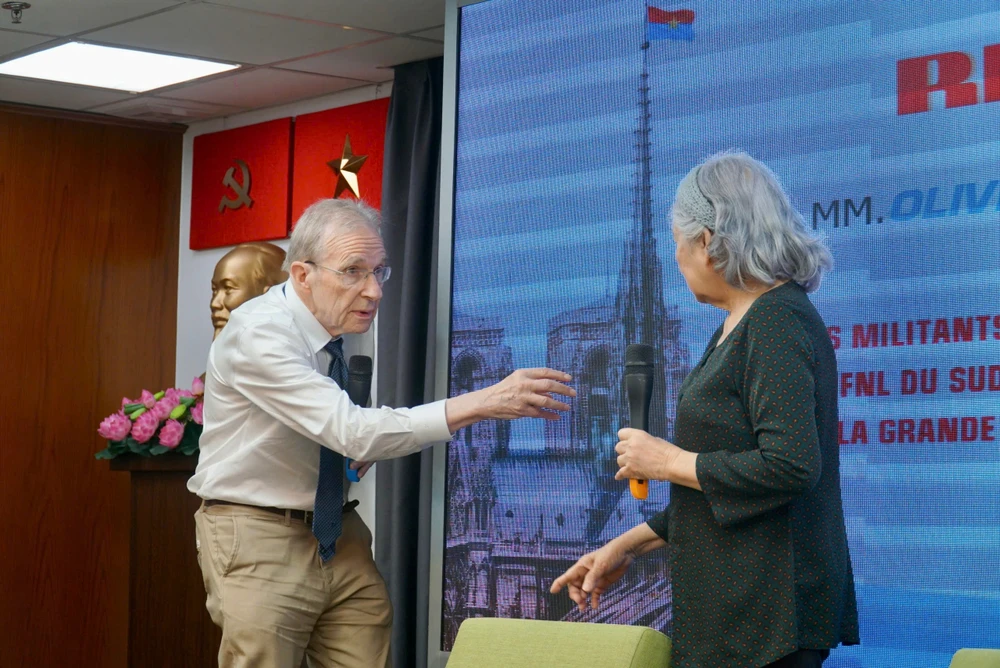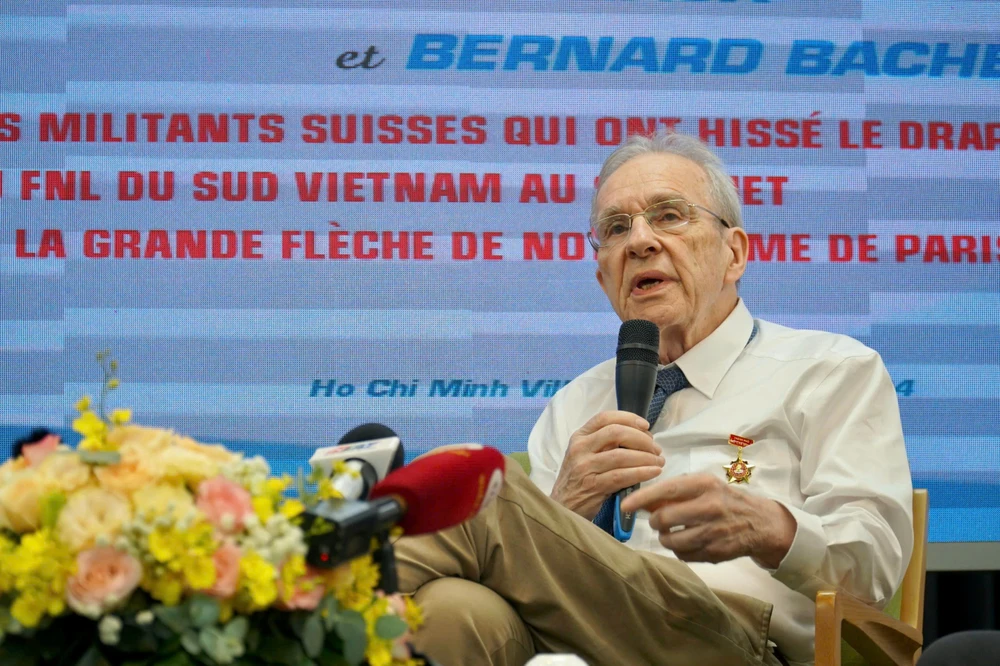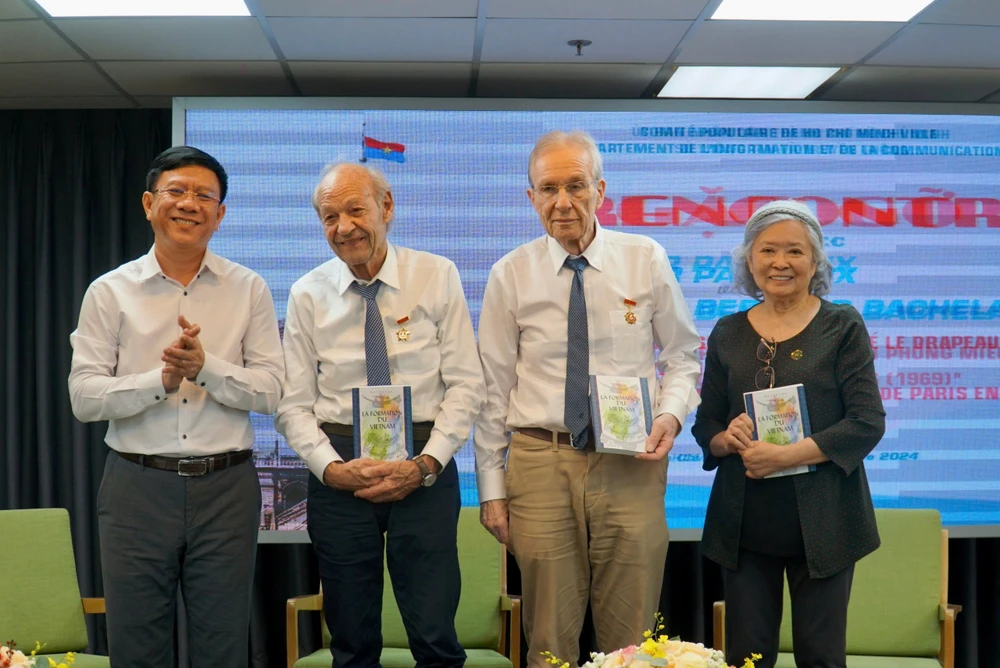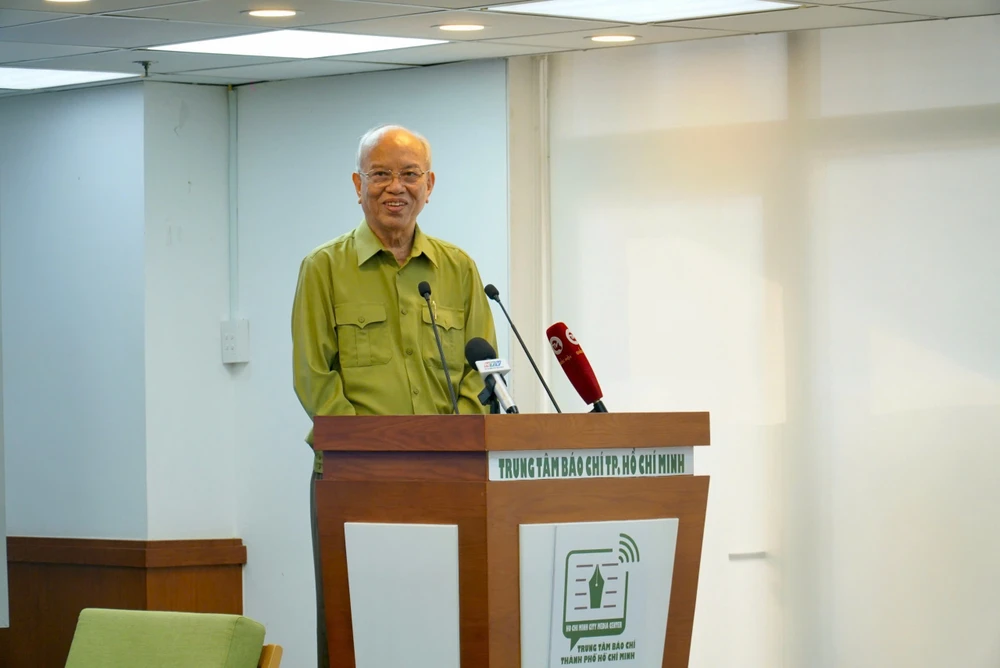Table of Contents
(PLO) – The flag of the National Front for the Liberation of South Vietnam on the spire of Notre Dame Cathedral in Paris, France, was secretly sewn by hand by the wife of Mr. Bernard Bachelard.
On the evening of November 18, at the Ho Chi Minh City Press Center, Mr. Olivier Parriaux and Mr. Bernard Bachelard (Switzerland) – the person flying the flag of the National Front for the Liberation of South Vietnam on the top of the tower Notre Dame Cathedral in Paris, France, 1969 – there was a meeting and share stories yourself with the press.
At that time, Bernard Bachelard was only 26 years old, a physical education teacher, Noé Graff (24 years old) was a law student and Olivier Parriaux (25 years old) was a physics student . These are young people who were active in the anti-war movements made by the Americans and the French before in Vietnam.
Support the struggle of the Vietnamese people
At the meeting, Mr. Olivier Parriaux shared with reporters the motivation for flying the flag of the National Front. Liberation of South Vietnam on the spire of Notre Dame Cathedral in Paris.

According to him, at that time in Paris, the preparatory session of the Paris Conference (Four-Party Conference, talking about ending the war and restoring peace in Vietnam, the including the Democratic Republic of Vietnam, the United States and the United States) taking place.
You have followed the struggles against colonialism and imperialism in several countries, including France, with millions of participants.
at the moment The Paris Conference regarded by them as the culmination of the struggle in Vietnam. “Conscience politics “We were created from there” – he said and emphasized that what he did was to support the struggle of the Vietnamese people.

Referring to his memories of that year, Mr. Olivier Parriaux said that the “ground” of Notre Dame Cathedral in Paris was difficult, he researched strategies to be able to climb to the top of the tower. a churchthat is the position where the flag hangs (different from the roof of the church). This “mission” was done by them in about 30 hours.
According to Mr. Olivier, at about 6 am on January 18, 1969, he and his “companions” traveled from Lausanne (Switzerland) and followed a group of guests. tourism to reach the highest place of the church. After the tourists left, they climbed over a fence, wrapped themselves around the flag and jumped over the space between two roofs, climbing the steps of the iron bar about 100 meters ‘ height to reach the destination of the hanging position of the flag – the highest point in the Cathedral of Notre Dame Paris.
“The movement process was very difficult. When I was almost there, I stopped and Bernard Bachelard continued to climb, tying the first hook of the flag” – said Mr. Olivier Parriaux and he said, after the movement of pulling , the Sun flag of the South Vietnamese National Liberation War flying on the spire of Notre Dame Cathedral in Paris. “That means victory” – said Mr. Olivier Parriaux happily.
In particular, on the way down, they used a small saw blade to cut iron bars to prevent the police force from climbing up and removing the flag when they found it.

On the way back to Switzerland, they stopped at the headquarters of the daily newspaper Le monde to send a press release. While passing through a square, they were stopped by French police but luckily they were let in when the police saw a car with Swiss license plates.
According to Mr. Olivier, at about 4:00 a.m. on January 19, 1969, the police saw the flag but when they tried to climb up to get it, they discovered that the iron bars were no longer there. At 3:00 pm the same day, plane A helicopter was dispatched to retrieve the flag. However, at this time, the media has talked about your work in many countries.
“We believe that this event contributed to the initial impact of the Paris Conference” – he said.
Speaking about the terrible flag, Mr. Bernard Bachelard said that his wife sewed the flag by hand in secret.
The flag has an area of 17 m2sewn with silk for easy transport and “designed” so that the flag flows with the pull of the string.
Only courage
Sharing with reporters about his feelings at the historic moment, Mr. Olivier Parriaux said that he and his “teammates” had no thoughts or training, only mental and physical courage.
“When the police stopped us in the street, we thought we would be arrested if we went to jail. Noé Graff and I have no problem, but Bernard Bachelard could be affected because he works in a state agency. ” – said Mr. Olivier.
He continued, there are risks but they don’t make us step back because we think about the future war of Vietnamese friends, with their political conscience.

He said the struggle of the Vietnamese people it is a unified, qualitative fight association and the result was victory.
He emotionally shared that he had been warmly welcomed in the past few days by the people in Ho Chi Minh City and that he would tell these stories to his friends in his hometown.

So, 55 years have passed, at that time, you fought for peace, independence, and unity of the Vietnamese people. And now, you are fighting another “war”, which is against the corporations that produce Agent Orange – the negative effects of which the Vietnamese people still have to suffer.
Trembling with emotion
That morning, when I heard that there was a flag of the National Front for the Liberation of South Vietnam on the spire of Notre Dame Cathedral in Paris, I held a small camera with both hands but I was still shaking with the feeling of the Front flag National for the Liberation of South Vietnam.

We consider the actions of the two men as very noble and brave. Although no one knows who hung that flag, it made a mark, serving as a call to everyone world against an imperial attack…
GS QUANG PHU TRIANGLE, Director Oriental Development Research Institute

1. Can you tell us more about the importance of the flag of the National Front for the Liberation of South Vietnam in the context of the Paris Conference?
2. How did you feel when you saw the flag being flown atop the Notre Dame Cathedral?
3. What were your thoughts on the risks involved in this act of protest and how did you manage to overcome them?
4. What was the reaction of the French authorities and other attendees of the Paris Conference to this event?
5. how do you think this action contributed to the Vietnamese struggle for independence and what lessons can be learned from it?



